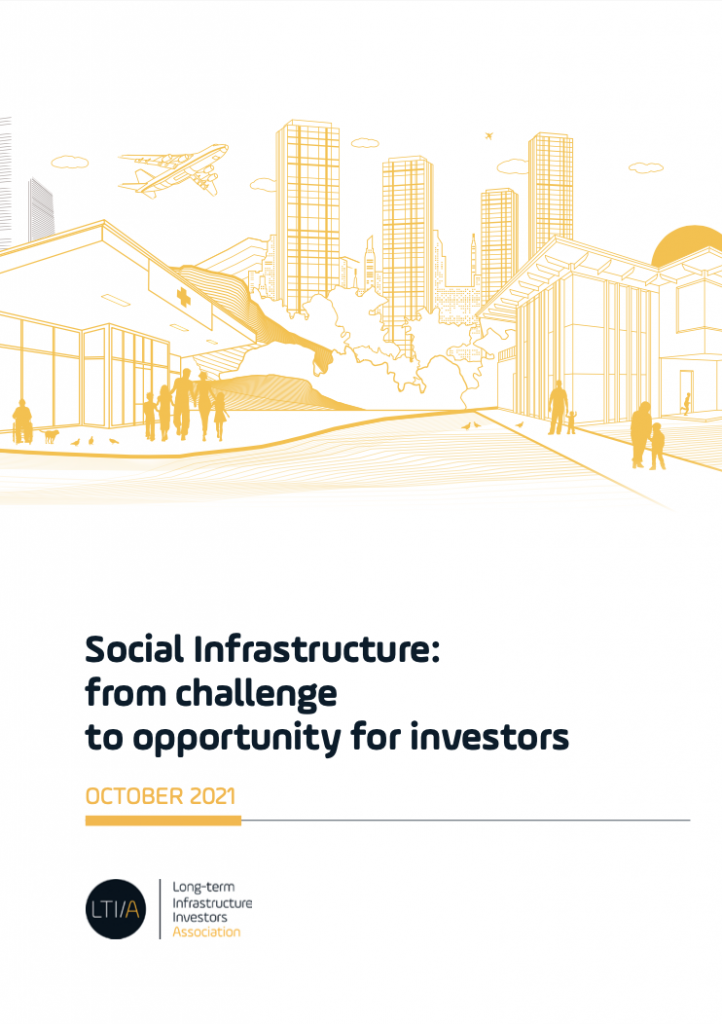This article, published on Linkedin, is a summary of the main takeaways from the October 2021-LTIIA report available on:
While human capital is now widely acknowledged to be a key driver of a resilient economic development, it is in turn is largely underpinned by social infrastructure: the facilities, buildings and intangible assets that serve to generate key collective services in healthcare, education or affordable housing.
So, it should be a concern to everybody that the stock and quality of social infrastructure has not kept pace with the needs, in advanced economies and emerging ones alike. Chronic public underinvestment has generated an investment gap over time. This was cruelly highlighted during the COVID crisis, when healthcare and education infrastructure had to adapt to unprecedented circumstances. The current situation is likely to worsen with future needs linked to big demographic and societal trends at play; as for the public sector( still accounting for 95% of total social infrastructure investment in Europe over last 5 years), its capacity to provide appropriate levels of financing is at risk in view of increasing public debt and deficit issues in many countries. Indeed, while all infrastructure sectors are impacted by this fiscal constraint on investments, social
Drawing on the vast pool of experience and contributions of its members, as well as from associated networks representing long-term public investors, the LTIIA report takes stock of the current market , with a sectoral focus on healthcare (the preferred sector for private investors’ social infrastructure strategies), education or affordable housing sectors and provides a mapping of corresponding main private actors, whether lenders or equity investors, illustrated by a wealth of case studies and examples.
It then dives deeper and analyses the current constraints and challenges limiting institutional investors’ share of the market.
Among the main challenges identified by LTIIA report on Social infrastructure :
- Insufficient project pipelines: The lack of comprehensive investment plans and poor integration into national agendas lead to a dearth of well-structured and investable projects, creating demand-supply imbalances and fierce competition for existing projects. As a result, primary market (greenfield , new investments) has somehow declined over the years, with the 2-ary market (brownfield activity such as acquisitions of existing assets), accounting for more than 3/4 of European social infrastructure deal value in 2020.
While secondary markets hold a number of merits for private investors, by catering to those investors that are not yet ready to assume design and construction or future demand risks, offering an opportunity to enhance the value potential of existing assets through reinvestment and retrofitting, and fostering market liquidity in what are fundamentally unlisted, illiquid assets, this has also resulted in an:
- Asset price bubble: Pressure to put vast amounts of dry powder to work has led to inflated project valuations in private markets and high acquisition prices. This, coupled with counterparty creditworthiness concerns, may deter private investor participation in potentially overvalued investments.
- Reputational risks: Social infrastructure investments’ long-term nature and direct impact potential (Particularly in sectors like Healthcare, where human lives are at stake) make them more prone to reputational risks for investors
- Supporting the social narrative: For investors who see social infrastructure investments as a way to boost their exposure to the ‘S’ component of ESG, data challenges associated with ESG investments make this impact difficult to quantify and assess.
- Size matters: The relatively smaller asset and project sizes associated with social infrastructure often places projects in this sector outside the scope of private investors-
- Regulatory issues & Legitimacy roadblocks: Social Infrastructure investments’ close link to Government agendas make them subject to heavy regulatory oversight, which are often considered burdensome for institutional investors while country-specific roadblocks such as cultural, political impediments, also limit private investor participation.
These constraints have been significant enough to offset the attractiveness of social infrastructure investments, effectively minimising institutional investors’ allocation towards the asset class. In this context, we propose the following recommendations to the various actors & stakeholders as a way of fostering further private investment into social infrastructure:
For Policy Decision-makers/ public authorities, the recommendations revolve mostly around the need to Increase and improve the deal flow of bankable/investable or asset recycling deals, while simultaneously establishing a better enabling and more investor-friendly environment for social infrastructure investments. For that, they need to:
- Improve capacity building and technical support for public procuring authorities
- Regroup/bundle similar projects through appropriate platforms
- Enhance the role of NPDBs to crowd in private investments
For National Promotion and Development banks (NPDBs), seen as a key player in leveraging and crowding in private investment:
- Assign private sector investment leveraging objectives in terms of multiplier ratios
- Implement adapted long term co-financing conditions, Share and pool experiences and best practices in crowding in private investors.
- help vital social infrastructure assets’ private owners to secure liquidity in times of crisis (as during COVID_crisis)
- leverage their influence on government spending policies and budgetary allocations to ramp up overall investments in social infrastructure
For Regulators:
National Regulators have to strike a delicate balancing act, ensuring that short-term affordability for consumers does not limit the investment needed to achieve long-term policy objectives, while maintaining light-touch regulation as much as possible. They would also have to reassess the financial regulatory framework (in the EU in particular) for a less penalizing prudential treatment long-term investors.
As for Investors (Asset owners and Limited Partners), they should:
- Reinforce their in-house expertise to address better project origination and selection
- Commit to active asset stewardship, either directly or through specialist Impact funds, in order to better manage reputational risk and reinforce their ESG credentials
- Explore creative and innovative contractual schemes to better negotiate the specific constraints of each subsector within different jurisdictions.
We at LTIIA firmly believe in the complementarity of private and public long term investment to come up with win-win solutions fostering sustainable development. Social infrastructure is among the most worthy causes to address in that respect.
François Bergere
